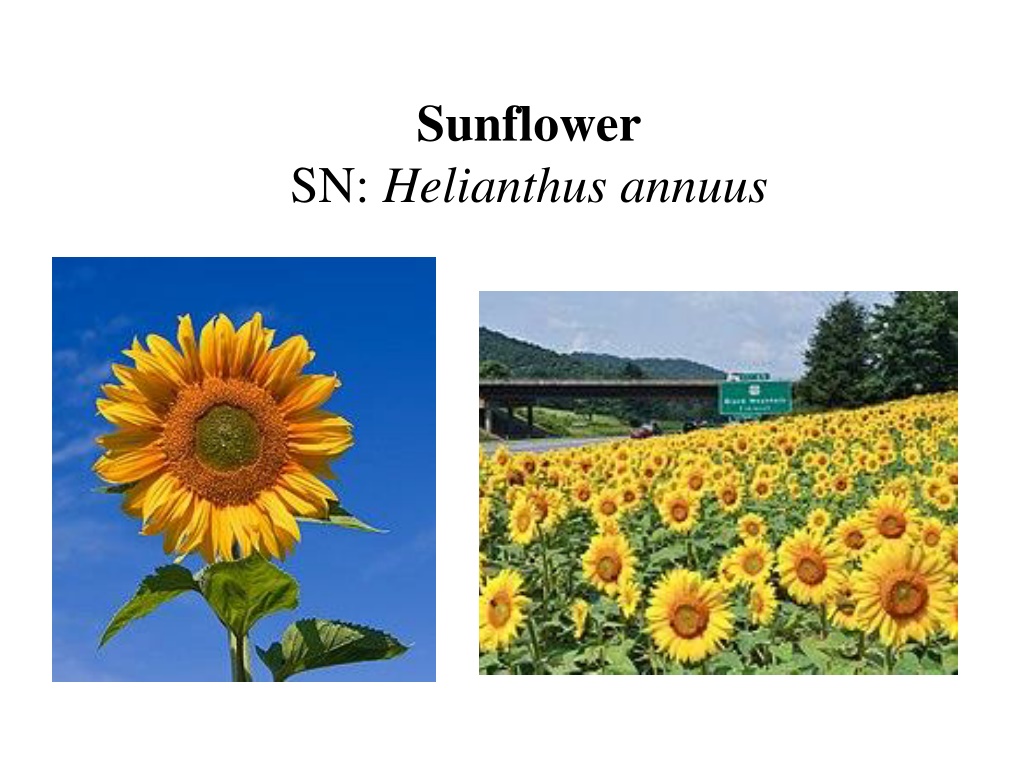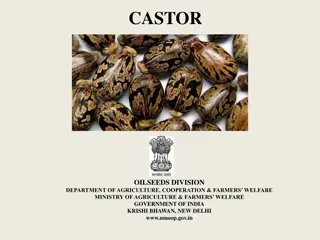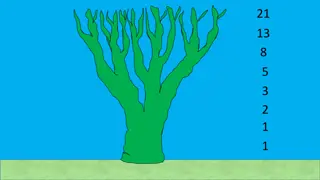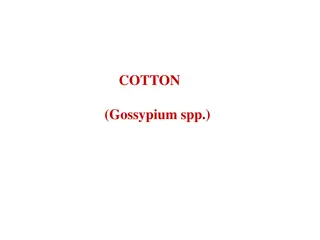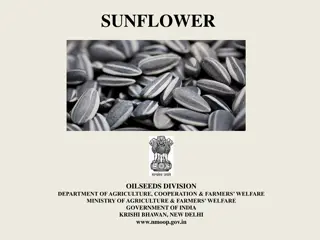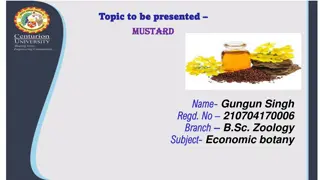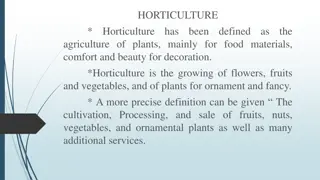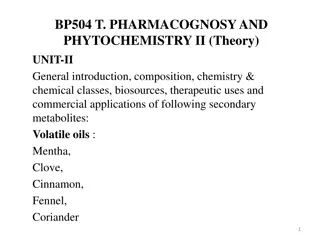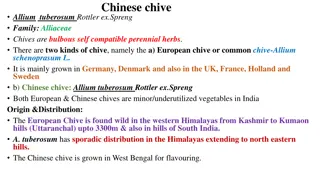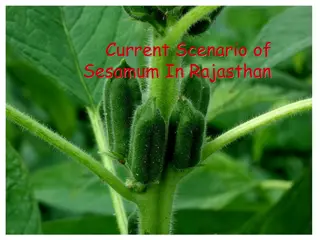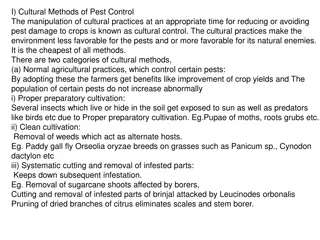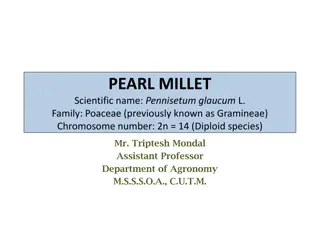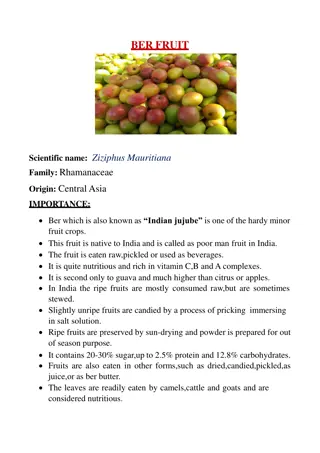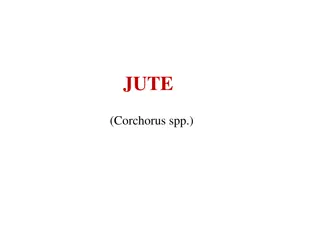Overview of Sunflowers: Economic Importance, Cultivation, and Distribution
Sunflowers (Helianthus annuus) are important oilseed crops with high economic value. They are cultivated worldwide for their oil-rich seeds, protein meal by-product, and diverse applications. Originating in the United States, sunflowers have spread globally and thrive in various agro-climatic conditions. With high oil quality, nutritional benefits, and adaptability, sunflowers play a significant role in agriculture and food industry.
Download Presentation

Please find below an Image/Link to download the presentation.
The content on the website is provided AS IS for your information and personal use only. It may not be sold, licensed, or shared on other websites without obtaining consent from the author. Download presentation by click this link. If you encounter any issues during the download, it is possible that the publisher has removed the file from their server.
E N D
Presentation Transcript
Sunflower SN: Helianthus annuus
Sunflower is an important latest additional to the list of edible oil seed crops in India. The genus Helianthus is named from the greek Helios meaning sun, and anthos meaning flower.
Economic importance Sunflowers are commercially cultivated mainly for the high value oil in seed. The by product after oil extraction forms an important protein meal in many food products and as feed in dairy industry. There is growing interest for non oilseed sunflowers as snack in the developed economies, besides there is increasing demand for sunflower as bird feed due to its preference by many species of birds. Sunflower seeds have high quality edible oil. It is rich in unsaturated oleic and linoleic acid (74% PUFA) and hence useful to human health. As these fatty acids are not produced in human body, consumption of sunflower is considered as essential. Sunflower oil hardly allows the blockage of blood vessels and do not result into higher cholesterol. They regulate blood pressure. The seeds contain average of 28% oil (maximum of 36%), while kernel alone contains 44-45% oil. The oil contains large quantities of vitamin E, sterols, and other aliphatic hydrocarbons, terpene and methyl ketones.
Origin: Sunflower is known to be originated in SW United States and cultivation of sunflower as food crop has been recorded only after 16th century. From its wild form, crop has spread and moved to Europe and former USSR. Where crop got domesticated. Sunflower as a cultivated crop was again reintroduced to N. America from Europe in later part of 19th century. Thus there are differences between eastern and western races of sunflower that exist in America. Though the origin and initial adaptation of crop was in temperate regions, crop was introduced to tropical countries like India during later part of 20th century. Now crop is well established in tropical countries also.
Area and distribution: Sunflower is cultivated in world in 23.8 mha with production of 28.3 mt, productivity is 1.3 t /ha. USSR is the biggest sunflower growing country in world. Other countries are Argentina, Ukrain, France and China. In India major states are Karnataka, MH, AP and other parts like Punjab, Haryana, UP, TN. Totally grown in area of 1.81 m ha with production of 1.16 m t. India has 4th largest area under sunflower in world. It contributes 6% of world production, accounts for 10% of world acrage.
Favorable features of sunflower grown in any country: Wide adoptability of crop in a wide range of agro climatic regions. Photoperiod insensitivity Short duration crop High yielding potential High oil quality High seed multiplication ratio (>1:80) Easy and cheaper cultivation of crop because of low seed rate, low water requirement, no specialized operation is required. It fetches high remuneration price in market. It is a non branch, determinant crop with single head. Features 1 and 3 makes this crop fit in to any cropping system thus it becomes more suitable for contingent crop planting under adverse climatic condition. Features 4 to 9 make this crop to replace low productive and less remunerative crops. Feature 9 makes it highly suitable for mechanized farming.
Plant structure and physiology of sunflower: In this crop, plant height is considered as yield component than growth. Plant is erect, hirsute, annual crop and grows to a height of 75-150 cm. Stem is often unbranched, thick and woody with terminal capitula or head. Leaves are mostly alternate with long stout petiole. The capitulum has diameter of 10-50 cm. The outer yellow 2 types of flower heads- outer yellow ray are sterile, whereas numerous discflorets arranged spirally. Pollination takes place through the action of bees or other pollination agents. Fruit is called as achene, which consists of kernel or seed+adhering pericarp (Hull). Test weight is 40-200g. In confectionary types we have test weight of 100g and above. Achene are obviate, compressed and pubiscent. It has tap root system reaching up to 150-270 cm with lateral spread of 60-100 cm. Roots concentrated at top 30 cm surface.
The roots of sunflower can go up to 4-5mt. Sunflower is C3 plant with high photorespiration. At flowering, it has LAI of 1.2 to 1.5 with dry matter capacity of 4 t/ha. It is having NAR of 10-18 g/m2 leaf/day and go up to 28g. Most of the varieties are insensitive to photoperiod i.e. flower in wide range of day length. It can also tolerate short duration of drought period without affecting either quantity or quality of oil yield. Due to mutation photosynthetic efficiency rates in sunflower crops vary from 50-65 mg CO2 per dm2 of leaf /hr. Thus it almost crosses C4 plants like corn, sorghum, sugarcane which have average PE of 50 mg CO2. The crop is capable of harvesting solar radiation up to 500-600 cals/cm/ day due to mutation, plant height, leaf structure. Therefore plant height is considered as yield component apart from drymatter production and diameter of head. However, oil content is negatively correlated with thickness of hull.
Y= No of heads/ha x No. of seeds/head x Average seed weight Number of seeds per unit area is very important yield component. Because most of cultivars producing single head, plant population becomes very important yield component. HI ranges from 0.33 to 0.35.
Climatic requirement Mean daily temperature for ideal growth in initial stage is 18 qnd 25oC, for later stages 21-25oC. It can tolerate cold temperature better than hot temperatures, as it can germinate even at 10oC. Hot temperature beyond 40oC may reduce oil yield, seed set. It is drought tolerant and is successful in rainy season, but requires irrigation, when grown in rabi/summer season.
Soil requirement It can be grown in any well drained soil, with good water holding capacity, having neutral pH 6-7.5. But, it can withstand salinity at r=the initial stages, but at later stages it needs neutral soil. Seeds and sowing Sown in first fortnight of July, second fortnight of October, and first fortnight of March respectively for kharif, rabi and summer crops in North India, while in south India, they are pre-poned by one or two months. Sowing is done by drill at the spacing of 60 cm rows for all varieties/hybrids usim=ng 5 kg seeds/ha, while Morden, it can be sown at row spacing of 45 cm using seed rate of 7.5 kg/ha.
Nutrient requirement In addition to 8-10 t/ha of manures, fertilizers supplying 60-80 kg N/ha, 60 kg P2O5/ha and 40-50 kg K2O /ha are necessary to be applied. Application of ZnSO4 @ 10 kg/ha to soil and foliar spray of 2% Borax solution are useful to increase the seed yields.
Weed management Critical stages for water: 20 days prior to and 20 days after flowering. Critical period of crop weed completion up to 60 days. Pre- emergence spray of Pendimethalin @ 1.5 kg ai/ha or pre-planting spray of Basalin @ 1 kg ai/ha is useful to control the weeds, besides intercultivations.
Seed setting and Filling: The sunflower production is often beset with poor seed setting and filling resulting in lower seed yields. This problem is more pronounced in sunflower cultivation in warmer regions of tropics and subtropics. In India, it is generally seen that seed filling under good management conditions is around 75% and it will be as low as 10-20% under poor conditions of the crop growth. The reasons for poor seed setting and filling can be 1. Genetic 2. Environmental 3. Physiological 4. Physical availability of pollinators.
Genetic: Though the disk florets are flowers with both female and male functioneries, the poor seed set is due to a. Low autogamy and or b. self incompatibility. Low autogamy is due to the protandrous nature wherein the pollen of one flower can not be viable to fertilize the stigma of the same flower which comes next day. Environmental factors and nutrition influence the degree of autogamy by modifying the periods of pollen viability and stigmatic receptivity. Self incompatibility is due to the failure to fertilize even under assisted pollination due to the incompatability reaction sites in sunflower occurring at the stigma, style and the ovule and this can only be rectified by plant improvements methods.
Environmental: Environmental factors greatly influence the seed setting and filling in sunflower though there is a inherent limit of autogamy as varied from genotypes (Ranganatha 1998). In general, hybrids have higher autogamy per cent than varieties. Rabi/summer seasons recorded higher seed set per cent than Kharif season in inbreds, hybrids and populations. Application of MgSO4 increased seed filling as well as seed yield. Boron application at ray floret opening stage improvrd seed set, filling per cent, test weight, yield and quality. Under no moisture stress conditions seed set per cent, filling and yield were higher than moisture stress conditions. Seed setting and filling was higher under well protected conditions without loss of foliage.
Physiological: Competition between source and sink during the early stage of anthesis and early seed setting when there is still vegetative growth of plant taking place. Competition between developing sinks which is a regular centripetal succession following anthesis pattern wherein late formed sinks has better chance of filling. Preventing basipetal movement of auxins from head by way of TIBA application improved auxin concentration in head resulting in increased translocation of photosynthates to sink. Directed application of TIBA to head results in increased filling and test weight. Physical availability of pollinators: Providing supplemental pollination either by hand pollination or through keeping bee hives increases the seed set per cent and filling.
Sunflower florets are arranged in a natural spiral having a Fibonacci sequence
The disk of a sunflower is made up of many little flowers. The ray flowers here are dried
Cropping systems: Sunflower forms an ideal component in many multiple cropping systems. Wider adaptability of the crop to different agro-climatic conditions and seasons, short- duration and non-branching and flexible nature of the crop provides an opportunity to include it in intercropping and sequence cropping with the major crops and cropping systems of different regions.
Intercropping: Intercropping is traditionally practiced under conditions to provide insurance against total failure with sole cropping due to inclement weather, pests and diseases. In India, nearly 70% of the cultivated land is rainfed fecing uncertain crop production. With major crops and varieties having 120- 140 days duration, sunflower with 75-100 days duration forms a perfect match to provide best time complementarity to achieve higher system productivity with minimum competition under intercropping situations. Sunflower + pigeonpea and sunflower + groundnut in pre determined row proportions are popular in southern states. The intercropping of sunflower + Castor in Andhra Pradesh and Gujarath, sunflower + soybean in Marathwada and vidharbha region of Maharashtra, sunflower + blackgram in Tamil Nadu and Uttar Pradesh are promising. On an average, groundnut + sunflower registered 36% yield advantage while pigeonpea + sunflower gave 24% higher additional yield advantage than sole crop of sunflower (Reddy et al. 1998). Short atatured and short duration sunflower genotypes were more suitable for intercropping with longer season pigeonpea genotypes and yields of sunflower + pigeonpea in 4: 2 row proportion and sole cropping (Ujjinaiah et al. 1991).
Promising intercropping systems involving sunflower for different agro-ecological situations in India. State Karnataka Soil type Alfisols Alfisols Alfisols Alfisols Vertisols Vertisols Vertisols Vertisols Alfisols Alfisols Alfisols Alfisols Alfisols Vertisols Vertisols Efficient intercropping Ground + sunflower Groundnut + sunflower Pigeonpea + sunflower Fingermillet + sunflower Pigeonpea + sunflower Pigeonpea + sunflower Soybean + sunflower Groundnut + sunflower Groundnut + sunflower Pigeonpea + sunflower Castor + sunflower Groundnut + sunflower Castor + sunflower Groundnut + sunflower Castor + sunflower Row 4:2 3:1 1:2/1:1 4:2 3:1 2:2 2:1 6:2 6:2 1:2 1:2 3:1 1:1 1:1 1:1 LER 1.60 1.46 1.40 1.25 1.29 1.30 1.60 1.40 1.20 1.50 1.02 1.20 1.02 1.30 1.30 Maharashtra Andhra Pradesh Tamil Nadu Gujarat
Sequential cropping: Sunflower crop fits well in many crop sequences due to its relative insensitivity Karnataka southern region Rainfed Sunflower-fingermillet Cowpea-sunflower Rice-sunflower Cowpea-sunflower-maize Groundnut-sunflower-fingermillet Sorghum-soybean-sunflower Cotton-sunflower Pigeonpea+cowpea-sunflower Maize-sunflower-groundnut Sunflower-groundnut Sunflower-wheat/chickpea/safflower Groundnut-sunflower Cotton-sunflower Cotton+urdbean/mungbean+sunflower Rice - sunflower Soybean- sunflower Maize- sunflower Sunflower-chickpea Sunflower-groundnut Irrigated Northern region Rainfed Irrigated
Harvesting: Depending on the variety planted, sunflower crop will mature in about 90-120 days. The weather modifications through higher or lower temperature may alter the duration by a week. Harvesting can be made any time after the plant attains physiological maturity. At physiological maturity, the seed attains maximum weight and oil concentration. The best of benefit from the crop in terms of highest seed and oil yield and oil quality can be obtained by harvesting the crop at physiological maturity. But the seed moisture content at this stage will be high at 30-40%. Harvesting at this stage demands higher drying costs for safe storage and processing and thus it is delayed up to harvest maturity. Wherein the seed moisture content reduces to 10-12%.
Physiological maturity is determined visibly on the plant when the back of the heads turn from green to lemon yellow colour. Harvesting the crop at field level can be done when the back of heads turn to lemon yellow colour, 10% of the heads have turned brown, and the florets attached to the tip of the seeds drop off naturally. There will be 5-6 green leaves at the top at physiological maturity and all leaves dry by harvest maturity. At times of urgency or for obtaining uniformity for combine harvesting, dessication using a chemical defoliant can be used to shorten this period. The recommended chemical is DIQUAT marketed under the trade name REGLONE-EC at 2-3 litres along with a wetting agent in 100 litres of water sprayed at physiological maturity. Delay in harvesting beyond harvest maturity causes reduction in seed yield due to lodging of plants, greater bird damage, rodent damage, termite damage, etc., and reduces the oil quality in terms of increased free fatty acids oil (Robestson et al. 1978). Harvesting is done by separating heads from stem either manually or using combines. Monitoring the seed moisture content to keep it below 10-12% for threshing is important. The seeds can be separated from heads by beating with sticks manually or by using manually or power operated threshers. Thorough drying of the seed to reduce the moisture content to 9% is essential for safe storage.
Pest and Disease management: Soil borne diseases and their management: Downey mildew : Plasmopara helianthis Root and collar rots : Sclerotium rolfsii, Rhizoctonia solani, R. bataticola Stem rot or wilt : Sclerotinia sclerotiorum Vascular wilts : Pseudomonas sp., Fusarium sp. Management: Clean cultivation by removing crop debris. Avoid continuous sunflower cultivation Deep ploughing and summer ploughing Avoid irrigation/rain water from one field to other Uproot and burn the downy mildew affected plants. Seed treatment with Thiram or Ziram or Carbendazim @ 2-2.5 g/kg seed, APRON 35 @ 5 g/kg seed in downy mildew areas. Growing resistant varieties: LSH 1 and LSH 3 are downy mildew resistant hybrids.
Virus diseases and their management: Sunflower mosaic virus (SMV): Mechanically sap transmitted by many vectors, viz. Aphis gossypii, A. craccivora, A. malvoe, A. fabae, Myzus persicae and Rhopalsiphum maidis. Aphid transmitted virus Yellow ring mosaic virus Tobacco streak virus-transmitted by mechanical sap and also by dodder. Sunflower necrosis disease- a new disease in south India. Mycoplasma like organisms: Aster yellows: Transmitted by leaf hopper, Macrosteles fascifrons Phyllody: Transmitted by leaf hopper, Orocoius albicinctus Management: Follow clean cultivation Prophylactic sprays to control sucking pests- systemic insecticides like dimethoate, phosphomidon Carefully select and destroy the affected plants Chattopadhyay (1998) compiled and presented a brief details of foliar diseases of sunflower and their management.
Foliar diseases and their management: Alternaria blight and leaf spot: Alternaria helianthi, Alternaria zinnae Rust : Puccinia helianthi Bacterial leaf spot : Pseudomonas syrinae p.v. helianthi Rhizopus head rot : Botrytis cinera Pers. Ex Fr. Cladosporium head rot : Cladosporium herbanum (Pers.) Link ex S. F. Gray Management: Clean cultivation by removing crop debris. Adjustment in sowing time to avoid disease outbreak periods Mancozeb @ 0.2% a.i., for Alternaria and rust; Sulphur 0.2% for powdery mildew and botrytis; Blitox @ 0.4 % for rhizopus ro
Insect and their management: Seedling pest: Cutworms Managenment : Grow sunflower on slopes of ridges. Aldrin (30 EC) or Chlorpyriphos (20 EC) or Imidocloprid (25 UP) soil application. Monocrotophos bait in evening hours and enosulphon drenching (0.05% Non insect pests: Dove, field rats, crow and striped squirrel) Management: Poison baits and bird watch Defoliators:Spodoptera, Spilosoma, Trichoplusia, Plucia, Grass hoppers, Weevils. Management: Regular scouting to identify egg satge or gregarious stage to remove and destroy. Setting up of light traps to attract adult moths in Kharif Clean cultivation with bund cleaning. Sucking pests: Leaf hoppers, plant hoppers, thrips, aphids, jassids, plant bugs and white fly. Management: Maintain/retain coccinellid population Chemical spray with systemic insecticides Seed treatment with Imidocloprid Inflorescence Pests:Helicoverpa armigera Management: Maintain/retain natural enemies Use NPV @ 500 LE/ha 3 sprays Use of Pheromone traps Phosalone 0.05% or Monocrotophos 0.05% or Cypermethrin 0.005% or Fenvelrate 0.005% etc.
